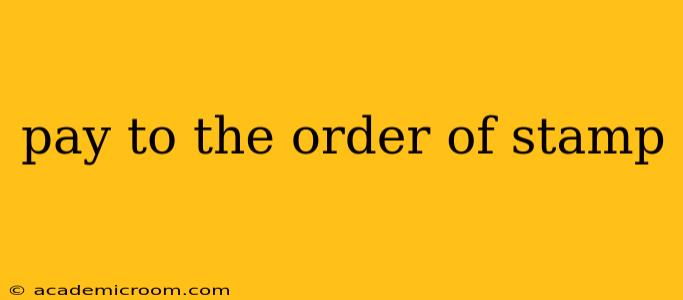The "Pay to the Order Of" stamp, often seen on checks and other financial documents, plays a crucial role in ensuring secure and legitimate transactions. This guide explores its significance, usage, and legal implications, answering common questions surrounding its function. We'll delve into its history, its importance in preventing fraud, and its practical applications in today's financial landscape.
What is a "Pay to the Order Of" Stamp?
A "Pay to the Order Of" stamp is a type of endorsement stamp used primarily on checks and other negotiable instruments. It's used to formally transfer ownership of the financial instrument to a specific individual or entity. Unlike a simple signature, the stamp indicates a clear, legally binding transfer of funds, minimizing the risk of unauthorized access or fraudulent activities. The stamp typically includes the words "Pay to the Order Of" followed by a space for filling in the payee's name.
Why is the "Pay to the Order Of" Stamp Important?
The importance of this stamp stems from its role in preventing fraud and ensuring secure financial transactions. Without a properly endorsed check, the check could potentially be cashed by someone other than the intended recipient. The stamp provides an extra layer of security and clearly identifies the legitimate recipient of the funds. It creates a verifiable paper trail, supporting accountability and minimizing the risk of disputes.
What are the Legal Implications of Using a "Pay to the Order Of" Stamp?
Legally, using a "Pay to the Order Of" stamp is crucial for transferring ownership of a negotiable instrument. It establishes a chain of custody, indicating who legally possesses the right to claim the funds. Incorrect or missing endorsements can lead to legal complications, delaying or even preventing the successful processing of the check. The use of such a stamp helps adhere to legal requirements for transferring ownership of financial instruments. Misuse can have serious legal repercussions.
Can I Use a "Pay to the Order Of" Stamp on Any Document?
While primarily associated with checks, the principle of a "Pay to the Order Of" endorsement applies more broadly to negotiable instruments. Documents like promissory notes or money orders might also utilize similar endorsements to specify the intended recipient and secure the transfer of funds. However, its usage is not suitable for all documents, and context is important in its appropriate application. Consult with a legal professional for specific situations involving other types of documents.
How Does a "Pay to the Order Of" Stamp Differ From a Simple Signature?
A simple signature on a check merely endorses the check, allowing it to be cashed by anyone presenting it. This approach is less secure and susceptible to theft or fraud. A "Pay to the Order Of" stamp, however, restricts the funds to the specifically named recipient, greatly enhancing security. The stamp provides a clear and unambiguous method of designating the rightful recipient.
What Happens if the "Pay to the Order Of" Stamp is Incorrect or Missing?
If the "Pay to the Order Of" stamp is incorrect or missing, the check might be rejected by the bank. This would necessitate correction or re-issuance of the check, leading to delays and potential inconvenience. Banks usually have specific procedures in place to deal with such discrepancies, to prevent fraud and ensure the legality of transactions. Inconsistencies can also create legal complications, leading to potential disputes.
Where Can I Get a "Pay to the Order Of" Stamp?
"Pay to the Order Of" stamps are readily available from various office supply stores, both online and brick-and-mortar. Many online retailers offer a wide selection, providing various sizes and styles to suit individual preferences and business needs. These stamps are a cost-effective way to improve the security of financial transactions.
This comprehensive guide offers a detailed understanding of the "Pay to the Order Of" stamp, its functions, and its significance in secure financial transactions. Remember, while this guide provides informative content, always consult with legal professionals for advice on specific situations and complex legal matters involving financial documents.
